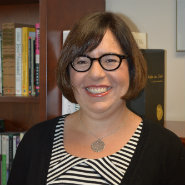
Keough-Naughton Faculty Fellow Amy Mulligan (D.Phil., University of Oxford) has won a prestigious one-year award ($50,400) from the National Endowment for the Humanities (NEH) for her project titled “A Landscape of Words: Ireland, Britain, and the Poetics of Irish Space from 700-1300.”
Mulligan, an assistant professor of Irish Language and Literature at Notre Dame, focuses her scholarship on medieval Ireland, though an overarching goal of her research program has been to put medieval Irish literature into transnational contexts and to demonstrate how Irish texts inform and are informed by other medieval North Sea literary traditions.
As Mulligan says, “I’m completely delighted about the support the NEH has shown for my work. I’m told that this is the first project with a Celtic element the NEH has funded, so I’m extremely pleased that in addition to supporting my own work on Irish place-writing and spatial discourses, the NEH is really helping to put medieval Irish studies on the map. This is so important for the field and for Notre Dame, where we have developed such strengths and world-class programs in both Irish Studies and Medieval Studies.”
“A great deal has been written about the prominence of landscape and the physical environment in Irish literature,” she explains, “but serious analysis of the Irish poetics of place has focused almost exclusively on modern sources. My NEH project expands this conversation to show that the literature produced by the medieval Irish contains perhaps the highest concentration of literary topographies in both Irish literary history and within the wider medieval European milieu, as only in Ireland was a distinct genre of placelore formalized and popular.”
In recent decades, “spatiality,” or consideration of what it means to be situated in space, has become a key concept in understanding human behavior, and has resulted in a widespread “spatial turn” across the disciplines. The development of spatial practices and their theorization has been tied to major historical innovations, including exploration of the Americas, the industrial revolution, and movement of populations to urban centers, as well as to empire-building and subsequent experiences of colonialism and diaspora.
These studies have neglected the pre-modern world, however—a gap Mulligan aims to remedy in her study of medieval Irish works.
As Mulligan puts it, the medieval Irish contribution was key. “I think the sources really prove that the medieval Irish theorization of place-writing , not to mention the extensive movements of Irish scholars and texts throughout Europe, enacted a medieval ‘spatial turn’ –one that has extensive implications for both medieval literature, contemporary spatial theory, and an understanding of how we engage with worlds built out of words.”
In her analysis, she will consider the theories and poetics of Irish place that were developed over these six medieval centuries in response to a variety of political, cultural, religious and economic changes. Thus, her proposal to the NEH outlined an ambitious take on what she calls the “greatest hits” of medieval Ireland –for example, Táin Bó Cuailnge (‘Cattle-Raid of Cooley’), Togail Bruidne Da Derga (‘Destruction of Da Derga’s Hostel’), and Dindshenchas Érenn (‘Placelore of Ireland’)—and a look at representative examples from a range of genres to track the consistent prioritization of spatial discourses, including those that involve Britain and other North Sea neighbors.
Mulligan came to Notre Dame in 2012, having previously held major research fellowships at the University of Oxford, the Centre for Viking and Medieval Studies (Oslo), the University of Michigan, the Institute for Research in the Humanities (Madison, Wisconsin), and the Centre for Medieval Studies (Bergen).